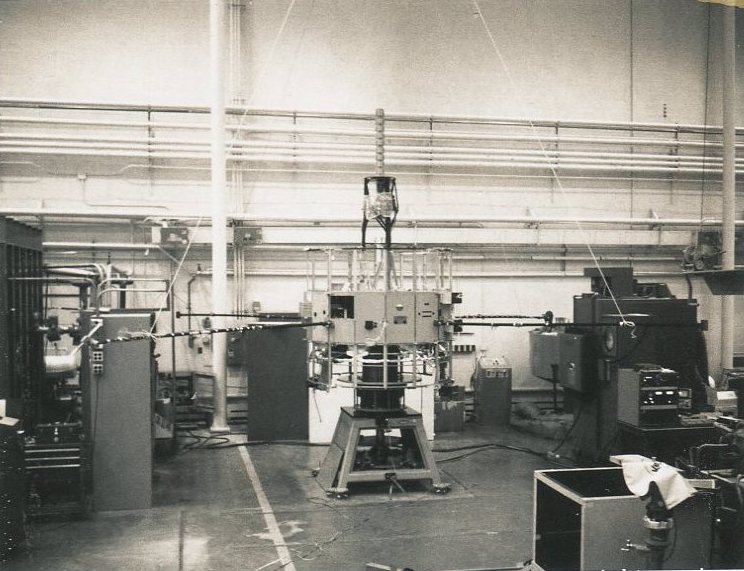Space Droids Are Part Of Human Space Families

Keith’s note: Below is an email from Todd Kramer. His father Richard Kramer died recently. Richard Kramer had a long career in the space business and worked on the ISEE-3 spacecraft in Maryland back in the 1970s. This note embodies a special connection his family had with space – something that I, as a on-and-off space person, can firmly attest to since I have had one myself.
Todd Kramer: “My Father was Richard Kramer. He was in charge of and assembled the ISEE-1 and ISEE-3 spacecraft at Fairchild in Germantown Maryland. He had a 40+ year career at Fairchild/Orbital and worked on, from my count so far, over 70 unique programs and hundreds of spacecraft. He died recently and I had the amazing chore of going through his mountain of files. I found this unique photo that was not in the original batch I sent to you all a few years ago. I believe it is ISEE-3 in the first stages of its build. The second is the mission decal (which is stuck to his tool box) which I have never seen before either. I copied every entry of your entire blog and read every article to him. Over the last few years of his decline, it was something we could bond over and talk about. So thank you for all your hard work. It was fascinating. Unbeknownst to me, we both wore our “reboot” T-shirts while doing yard work and such and have ruined them to shreds, however, I discovered a small cache of them he was hiding away.”
Keith’s Background: As some of you may remember back in 2014 Dennis Wingo and I had a crazy idea to contact the ISEE-3 spacecraft, wake it up, and get it to do science again. Actually this was legendary space orbital dynamics genius Bob Farquhar’s crazy idea – and Bob put a bug in our brains that would not leave. As such the ISEE-3 Reboot Project was born. We twisted NASA’s arm a bit to get them to let us salvage their abandoned spacecraft, crowd-funded $150K, and used the now-destroyed dish at Arecibo to talk to the spacecraft.
Since virtually everything was thrown out years ago we found original team members (including the Kramer family) who had ISEE-3 stuff in their garages, used modern software defined radio to “rebuild” lost support hardware and software, and managed to make it all work. Then, after getting the engines to fire and data from instruments, the spacecraft ran out of fuel, and flew past the Moon. It is now in safe mode in an orbit slightly larger than Earth’s. It may fly by us again soon but its now mostly a silent sentinel to the early days of NASA. You can still see ISEE-3 online as a snarky Twitter account that gives unwanted advice to other spacecraft however. An archive of the reboot project is here. We were space pirates before Matt Damon proclaimed himself to be one in “The Martian”.
It is heartwarming to get notes from people whose parents labored back in the earlier days of space exploration since my own interest goes back over 60 years. On a personal note, on the day that our team was going to make the first attempt at firing ISEE-3’s engines I was sitting in a hospital intensive care room with my father who had just had a serious stroke and was suffering from Alzheimer’s. I was live tweeting our engine firing using my laptop and a cellphone. Suddenly, the team did the right things and the engines fired. As amazed as anyone else I said loudly “We did it!” Suddenly my father became alert and started to talk. He had been utterly silent and unresponsive for many days up until that point. ISEE-3 did something that prompted me to do something and my Dad woke up. After that he continued on a path to semi-recovery.
At one point during my innumerable talks with Bob Farquhar he told me one story in particular that resonated with me – and with my interactions with people like Richard Kramer and my father. Bob liked to tell this story to everyone. FWIW Bob liked to tell stories – period. At one point in the mission the ISEE-3 spacecraft had a battery issue and lost power. According to an interview he gave to NPR: “His memoir makes it clear how personal. For example, Farquhar writes that when he was hospitalized after a heart attack, the spacecraft suffered a battery failure — making him believe they shared a “supernatural connection. “It’s my baby,” says Farquhar. “It’s something I worked on for a long time and I had to sell it to NASA, and sell it to a lot of people.” Bob always felt a kinship to this particular spacecraft and the hope that it could be re-contacted kept him going for many years. As such, when I was a pallbearer at Bob’s funeral, I felt yet another special, personal connection to ISEE-3.
You will often hear space people talk about the personal connections that they have with their spacecraft and missions – and the teams and crews that they worked with – connections that transcend time. These connections are very real are part of what makes being a space person extra special. So, the next time you see a space person at a post-mission press event grasping for the right words – or tearing up – when some reporter asks them “how do you feel” – well, its that personal to have a piece of yourself – a member of your family – out there amongst the stars.
Ad astra Richard Kramer.
- Rebooting ISEE-3: Space for All, Keith Cowing, New York Times
- The ISEE-3 Reboot Project, One Year Later, Dennis Wingo
- ISEE-3 Reboot Project, NASA



Leave a Reply
You must be logged in to post a comment.